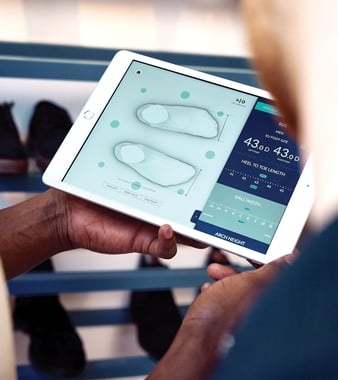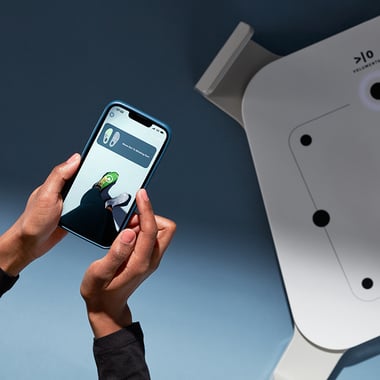Today's shoppers are more demanding than ever, and the proliferation of venues through which interactions with brands and retailers take place has increased omni-channel complexity. The success of the shopping experience depends on how well multiple touchpoints are connected to streamline consistency across the customer journey, remove friction, and deliver compelling personalization strategies.
Transforming the Physical and Digital Shopping Experience
While omni-channel retail is a reality, switching seamlessly from online to offline and vice versa is not always straightforward when browsing categories such as footwear that traditionally rely on physical try-ons for sizing. In this context, shoppers and store associates need the tools to expand the possibilities of both in-store and online experiences.
The physical store will continue to be the place for significant customer interactions, where shoppers can experience the product and store associates can offer advice and personalization. According to IDC research, brick-and-mortar stores are expected to deliver 68% of retail revenues in two years.
At the same time, ecommerce is growing rapidly, increasing from 13% of total retail revenue generated last year to 35% in the next two years, according to retailers surveyed by IDC. Online retail, far from replacing the in-person store experience, will become increasingly complementary to the physical store and will continue to expand the possibilities offered through a truly omni-channel customer journey.
With all channels equally important, two main trends are emerging:
-
To feed the brick-and-mortar transformation, retailers are investing in digital technology that connects the physical store with the broader omni-channel customer journey. For example, 71% of retailers are planning to invest in Internet of Things (IoT) for in-store customer experience in the next two years, according to IDC research.
-
Digital and physical commerce will become increasingly integrated as part of a consistent customer journey. For instance, 73% of retailers will be rolling out mobile shopping apps for both in-store and online shopping in the next two years, IDC research reveals.
Personalization Key for Effective Customer Journeys
Personalization is key to successful customer experiences across the omni-channel shopping journey. Being relatable and developing an inside-out knowledge of the shopper is crucial for customer acquisition and retention.
For categories such as footwear, personalization is instrumental not just in delivering the messages and content that resonate with the shopper, but also in ensuring that the right product is always delivered at the right time.
Customer data is instrumental in achieving personalization, with brands and retailers increasing their ability to analyze and act on shopper information gathered across the shopping journey. This is enabled by Big Data and advanced analytics, where retailers and brands are focusing their investment, with about half of retailers worldwide surveyed by IDC intending to invest in artificial intelligence (AI) and cognitive technologies for customer experience personalization over the next two years.

Digitizing Fitting for Seamless Online-Offline Retail Experience
In footwear shopping, digitizing a part of the customer journey such as fitting helps to connect online and offline experiences and improve personalization. Virtual fitting — combining AI, machine learning, and computer vision — enables shoppers to identify the right fit without physically trying the item on. This effectively connects online and offline. Also, it ensures greater knowledge of customers and enables increasingly seamless customer experiences thanks to the wealth of data gathered through the technology.
Today's consumers, especially among the younger segments, expect to virtually interact with the product, such as through digitally simulated try-ons to ensure the right fit. If they can't do this, they will go elsewhere. According to IDC's latest consumer surveys, 65% of shoppers aged 18 to 25, a key target segment for sportswear shoes, are likely or very likely to shop elsewhere if the brand or retailer does not let them interact with the product virtually via online simulation, augmentation, and/or virtual reality mechanisms, such as virtual footwear try-ons.
How Virtual Fitting Technology Can Boost the Bottom Line
Deeper customer knowledge delivered by technology such as virtual fitting enables retailers to become more efficient, cost-effective, and sustainable by ensuring that shoppers are provided with relevant offerings. Retailers that deliver products that exactly match each shopper's expectations and requirements will drastically reduce returns and generate repeat sales. Those that leverage virtual fitting technology are more able to offer personalized omni-channel customer journeys, resulting in:
-
20%–30% sales increases
-
2–3x conversion increases for emails and ecommerce experiences
-
>75% targeted email open rates
-
15%–20% net promoter score (NPS) increases
-
18% average reduction in returns
Greater customer knowledge and improved omni-channel experiences through virtual fitting technology reflect positively on the bottom line, as the brand or retailer shows that it can provide offerings that resonate with and respond to the needs and expectations of today's demanding and channel-agnostic consumers.

Conclusion: Leading Brands and Retailers to Focus on Virtual Try-Ons for Competitive Edge
Retailers and brands are facing an increasingly challenging and fast-moving trading environment in which competition is stiff and higher consumer expectations require ambitious omni-channel journeys. Technology such as virtual fitting can become a building block and a key enabler to streamline operations to keep up with today's and tomorrow's challenges.
IDC Retail Insights predicts that by 2024, 65% of retailers will invest in visual commerce to enable personalization through 3D product configuration and virtual try-ons, and to reduce complexity through image-based interfaces. Increasingly, forward-looking companies are turning to best-in-class technology to achieve greater personalization and deliver truly omni-channel customer journeys by offering tools that enable frictionless, personalized, and channel-agnostic customer experiences.
